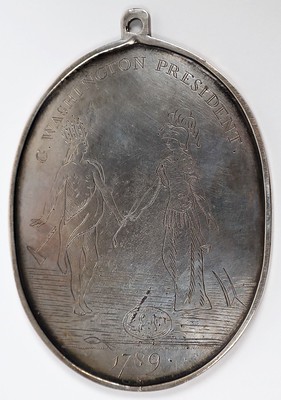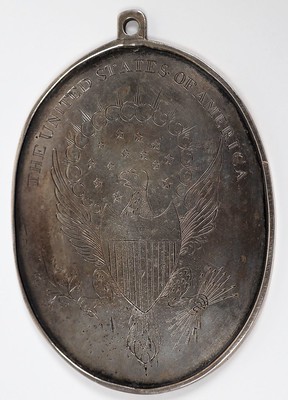
Another lot of note in the upcoming Holabird sale is a study collection of modern and fake Indian Peace medals. See the complete description by Bill Hyder and Fred Holabird online. Here's an excerpt.
-Editor
The Larry Swick Peace Medal Collection, Pine Ridge Reservation: A Collection of 84 Peace Medals with Notes of Provenance in Lakota and English
This collection of 84 Peace Medals was assembled by a Pine Ridge Reservation farmer, the only white family within the Reservation. He collected the medals over the 1976-1978 period at a time when the modern-day American Indian Movement was at its height. As such, the collection has a level of important cultural significance previously unenvisioned by collectors and historians.
At first glance, several appeared original, but most were clearly from the post-1903 restrike period, many altered in some way. Nine medals are new products from the U.S. Mint presidential list, a product of modern-day collection of restrikes from the US Mint, and one is a new restrike of George III peace medal. One surviving invoice from 1978 hints that these may be among the last he purchased.
With three exceptions, the remaining 74 medals have been mechanically ground to round the edges and smooth the high points on the medals. In some instances, parallel reeding-like machine marks appear along parts of the rims. Following the smoothing process that we assume was meant to make the medals appear worn and old, additional grinding or file marks are obvious on the highest points. The medals then appear to have been acid washed to dull the bright surfaces created by the grinding. In some instances, the medals were given red paint or silver, adding to an illusion of age. The medals have drilled loopholes with rings attached and ribbons in many cases. With a few exceptions, the loopholes do not show wear consistent with the simulated wear. Fifty-nine medals have written documentation on pencil, hand-written notes authenticating the medals and who owned them. Many of the notes are handwritten in Lakota, sometimes with an English translation.


At first glance, a John Tyler large silver peace medal with a heavy nickel-silver chain and suspension loop as opposed to loophole could be the real thing. On closer examination it is 3mm smaller than the original, obviously cast, and has an enigmatic STERLING hallmark on the rim. These attributes clearly place the date of manufacture at the post-Tyler period. A second, fully silvered, James Buchanan medal also appears real before closer inspection. The reverse is that of the earlier Fillmore and Pierce medals indicating it is a later product of the U.S. Mint and in this specific case is from the Mint's Presidential series, produced after 1903. The note accompanying the medal indicates it was written in 1896 by Good Thunder who indicates it was worn by Spotted Thunder who died at Wounded Knee. The note then says his son owned the medal, although there is a blank space for the son's name. The envelope indicates the collector paid $125 for the medal.
Perhaps the most damning medal in the collection is the 1933 U.S. Mint, Benjamin Franklin medal engraved by John Ray Sinnock. Who ever produced these so-called Peace medals failed to recognize the micro-signatures and dates on the legitimate medal. It has been ground down and acid washed to make it appear old. The attached letter is dated Dec. 20. 191l, and says the medal belonged to Hump (1848-1908), Chief of the Northern Cheyenne. He died long ago. The drawing of the medal is signed by George Eagle Bear, Bridger, SD. Lacking the micro-initials of the engraver, the medal must not be original.
After examining each medal, we believe they are the work of one individual. Were they created to honor those past who were awarded these medals, or made to deceive? Swick was not a medal collector, nor professional numismatist.
Many of the medals are accompanied by invoices from Lighthouse Antiques in Gordon, Nebraska. While not all medals have accompanying invoices or noted purchase price on envelopes, we estimate Larry spent nearly $15,000 over two years building the accumulation. Opal Munro opened the Lighthouse Antique store in Gordon, Nebraska in 1969 and catered to tourists. In one newspaper account in the early 1970s, it was noted that Jim Fire Thunder of Gordon made drums and other Indian artifacts that are displayed at Lighthouse Antiques.
To read the complete lot description, see:
Peace Medal Collection of Important Cultural Significance [152641]
(https://holabirdamericana.liveauctiongroup.com/Peace-Medal-Collection-of-Important-Cultural-Significance-152641_i45936018)
Wayne Homren, Editor
The Numismatic Bibliomania Society is a non-profit organization
promoting numismatic literature. See our web site at coinbooks.org.
To submit items for publication in The E-Sylum, write to the Editor
at this address: whomren@gmail.com
To subscribe go to: https://my.binhost.com/lists/listinfo/esylum
Copyright © 1998 - 2024 The Numismatic Bibliomania Society (NBS)
All Rights Reserved.
NBS Home Page
Contact the NBS webmaster
|
